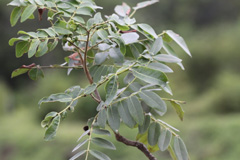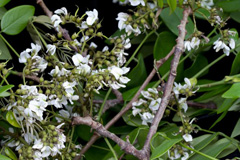 |
|
https://edibleplants.org/ |
 |
| https://edibleplants.org/ |
Translate this page:
Summary
A deciduous tree of about 20 m tall with cylindrical trunk that branches from low down, Dalbergia retusa or commonly known as Cocobolo is one of commonly exploited in the wild for its highly valued timber used for a wide range of items including knife and tool handles, musical
Physical Characteristics

 Dalbergia_retusa is a deciduous Tree growing to 20 m (65ft) by 20 m (65ft) at a slow rate.
Dalbergia_retusa is a deciduous Tree growing to 20 m (65ft) by 20 m (65ft) at a slow rate.
See above for USDA hardiness. It is hardy to UK zone 10. The flowers are pollinated by Insects.
It can fix Nitrogen.
Suitable for: light (sandy), medium (loamy) and heavy (clay) soils and prefers well-drained soil. Suitable pH: mildly acid, neutral and basic (mildly alkaline) soils. It cannot grow in the shade. It prefers moist soil.
UK Hardiness Map
US Hardiness Map
Synonyms
Amerimnon lineatum (Pittier) Standl Amerimnon retusum (Hemsl.) Standl. Dalbergia hypoleuca Pittier D
Plant Habitats
Edible Uses
References More on Edible Uses
Medicinal Uses
Plants For A Future can not take any responsibility for any adverse effects from the use of plants. Always seek advice from a professional before using a plant medicinally.
None known
References More on Medicinal Uses
The Bookshop: Edible Plant Books
Our Latest books on Perennial Plants For Food Forests and Permaculture Gardens in paperback or digital formats.

Edible Tropical Plants
Food Forest Plants for Hotter Conditions: 250+ Plants For Tropical Food Forests & Permaculture Gardens.
More

Edible Temperate Plants
Plants for Your Food Forest: 500 Plants for Temperate Food Forests & Permaculture Gardens.
More

More Books
PFAF have eight books available in paperback and digital formats. Browse the shop for more information.
Shop Now
Other Uses
Other Uses: A unique property of the species is the secretion of compounds that act as potent bactericides, fungicides and algaecides[ 381 ]. The heartwood is a very dark red, with faint streaks of black similar to rosewood (Dalbergia nigra); it is clearly demarcated from the thick band of nearly white sapwood. The texture is fine, the grain crossed, lustrous in colour with a faintly fragrant smell. The wood is hard, heavy, strong, tough, and durable in contact with the soil. It is rather difficult to work, but takes a good polish. It is used for a wide range of items including knife and tool handles, musical and scientific instruments, inlay, jewellery boxes, rosary beads, chess pieces and steering wheels[ 46 , 333 , 381 , 551 ]. This is the wood used commonly by indigenous people for carving[ 333 ].
Special Uses
References More on Other Uses
Cultivation details
We have no specific information on this species, but members of this genus generally prefer a fertile, loam soil and a position in full sun[ 200 ]. A slow-growing species[ 381 ]. Cocobolo responds well to fire. In areas experiencing periodic burning new saplings and small trees are observed to be numerous[ 381 ]. Trees often flower all year round[ 315 ]. This species has a symbiotic relationship with certain soil bacteria, these bacteria form nodules on the roots and fix atmospheric nitrogen. Some of this nitrogen is utilized by the growing plant but some can also be used by other plants growing nearby[ 755 ].
References Carbon Farming Information and Carbon Sequestration Information
Temperature Converter
Type a value in the Celsius field to convert the value to Fahrenheit:
Fahrenheit:
The PFAF Bookshop
Plants For A Future have a number of books available in paperback and digital form. Book titles include Edible Plants, Edible Perennials, Edible Trees,Edible Shrubs, Woodland Gardening, and Temperate Food Forest Plants. Our new book is Food Forest Plants For Hotter Conditions (Tropical and Sub-Tropical).
Shop Now
Plant Propagation
Seed - a germination rate up to 80% has been observed in the nursery[ 381 ]. Like many species within the family Fabaceae, once they have been dried for storage the seeds of this species may benefit from scarification before sowing in order to speed up germination. This can usually be done by pouring a small amount of nearly boiling water on the seeds (being careful not to cook them!) and then soaking them for 12 - 24 hours in warm water. By this time they should have imbibed moisture and swollen - if they have not, then carefully make a nick in the seedcoat (being careful not to damage the embryo) and soak for a further 12 hours before sowing[ K ].
Other Names
If available other names are mentioned here
Caviuna, Cocobolo, Cocobolo Prieto, Funeram, Granadillo, Jacarandáholz, Kaway tree, Nambar, ñamba, Nicaraguan Rosewood, Palisander, Palissandro, Palo Negro, Pau Preto, Rosewood, Urauna
Native Plant Search
Search over 900 plants ideal for food forests and permaculture gardens. Filter to search native plants to your area. The plants selected are the plants in our book 'Plants For Your Food Forest: 500 Plants for Temperate Food Forests and Permaculture Gardens, as well as plants chosen for our forthcoming related books for Tropical/Hot Wet Climates and Mediterranean/Hot Dry Climates. Native Plant Search
Found In
Countries where the plant has been found are listed here if the information is available
Belize; Costa Rica; El Salvador; Guatemala; Honduras; Mexico; Nicaragua; Panama
Weed Potential
Right plant wrong place. We are currently updating this section.
Please note that a plant may be invasive in one area but may not in your area so it’s worth checking.
Conservation Status
IUCN Red List of Threatened Plants Status : Status: Vulnerable A1acd

Growth: S = slow M = medium F = fast. Soil: L = light (sandy) M = medium H = heavy (clay). pH: A = acid N = neutral B = basic (alkaline). Shade: F = full shade S = semi-shade N = no shade. Moisture: D = dry M = Moist We = wet Wa = water.

Expert comment
Author
Hemsl.
Botanical References
Links / References
For a list of references used on this page please go here
A special thanks to Ken Fern for some of the information used on this page.
Readers comment
| Add a comment |
|
If you have important information about this plant that may help other users please add a comment or link below. Only comments or links that are felt to be directly relevant to a plant will be included. If you think a comment/link or information contained on this page is inaccurate or misleading we would welcome your feedback at [email protected]. If you have questions about a plant please use the Forum on this website as we do not have the resources to answer questions ourselves.
* Please note: the comments by website users are not necessarily those held by PFAF and may give misleading or inaccurate information.
To leave a comment please Register or login here All comments need to be approved so will not appear immediately.
|
Subject : Dalbergia_retusa
|
|
|
|